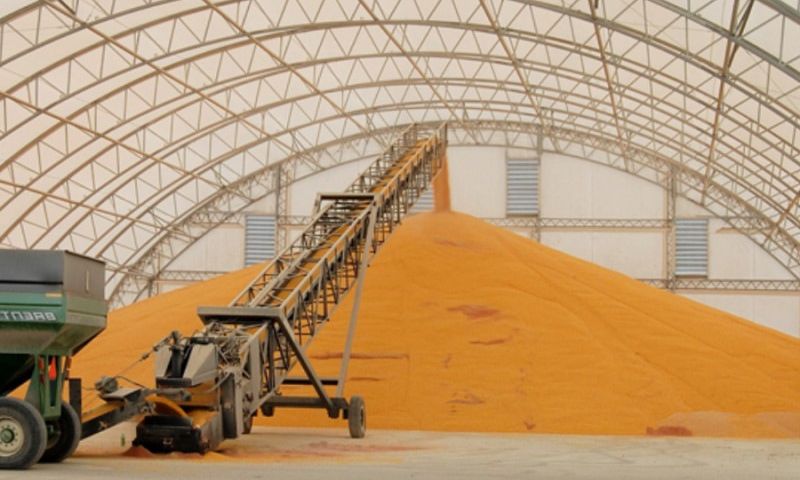Experts: Global disruptions on grain security to be limited

China’s grain security will not be disrupted by the impact of the Russia-Ukraine conflict and soaring prices of many agricultural products across the world this year, as its self-sufficiency in staple grain production remains high amid growing external problems, said experts and business leaders.
Despite global food and agriculture sectors facing uncertainty over crop yields and global trade flows, in the context of climate challenges, COVID-19-related turmoil and logistics challenges, experts and business leaders said China, backed by its 1.8 billion mu (120 million hectares) of arable land, new farming technologies and practical grain import policies, is capable of ensuring its grain security in 2022.
As the three staple grains, China’s production of wheat, rice and corn remains highly self-sufficient, said Wang Yongchun, a researcher at the agricultural information institute of the Beijing-based Chinese Academy of Agricultural Sciences (CAAS).
For example, the nation imported 9.71 million metric tons of wheat in 2021, which is a small proportion compared to the national wheat output of 137 million tons last year.
“As a result, price fluctuations in the global market may further push up grain prices and drive China grain import costs, but it will have a limited impact on the nation’s grain security,” he noted.
The sown area of rice in China has been maintained at about 450 million mu (30 million hectares) on an annual basis, and the annual output at about 210 million tons, said Wang, noting that imports are mainly used for variety adjustment.
China’s rice output reached 212.85 million tons in 2021, while it imported 4.96 million tons of rice, accounting for a negligible proportion of all rice supply, data from the National Bureau of Statistics and General Administration of Customs showed.
As one of the world’s leading countries in hybrid rice technology with a number of varieties, China had planted 600,000 mu (40,000 hectares) of rice in saline-alkali soil across the country by the end of 2021, said Zhong Yu, a researcher at CAAS’s institute of agricultural economics and development.
Under the government plan, the planting area for this kind of rice will grow in the country, bringing more food to people and improving the ecological environment in selected areas, Zhong added.
By the end of 2021, China’s grain production had been stabilized at over 650 billion kilograms for seven consecutive years as the largest grain producer and the third-largest grain exporter across the globe, the NBS data showed.
Premier Li Keqiang urged efforts to ensure grain security and energy supply to maintain the stability of the economy and prices in late June.
Li said grain production and energy supply are two pillars for stable commodity prices, and jobs and commodity prices are two key indicators of stable economic performance.
While laying a solid foundation for domestic grain production, China cannot ignore the international market. The supply and demand gap between soybeans and corn in the country still needs to be supplemented by imports. It is vital for China to further secure more import sources in other countries, said Nie Fengying, executive deputy director of CAAS’s overseas cooperation center.
Apart from importing 28.35 million tons of corn last year, China’s corn planting area amounted to around 650 million mu and the annual corn output reached 273 million tons in 2021, with a large volume consumed by feed and industrial sectors, said the NBS.
The Rome-based Food and Agriculture Organization of the United Nations predicted in March that China’s total cereal imports in the 2021/22 marketing year will be about 58.5 million tons, well above the last five-year average.
The large level of imports reflects a higher demand for feed crops, driven by the recovery in domestic pork production after the African swine fever outbreaks in 2018 and 2019 and the strong growth of the poultry, dairy and starch sectors. Imports of maize, mostly for feed, are forecast at a record level of 23.5 million tons in the 2021/22 marketing year.
“A more diverse import structure is needed to ensure consumers have access to a wide variety of affordable foods. For example, to mitigate impacts of rising prices for some crops, such as soybeans, other oil crops could be considered as alternatives,” said Jerrity Chen, head of the North Asia region of Louis Dreyfus Co, the French agricultural goods trader and processor.
As the world’s second-largest economy, China contributes largely to LDC’s trade flows, with increasing grains, oilseeds, coffee and sugar flow to meet growing demand.
Read also
Wheat in Southern Brazil Impacted by Dry Weather and Frosts
Oilseed Industry. Leaders and Strategies in the Times of a Great Change
Black Sea & Danube Region: Oilseed and Vegoil Markets Within Ongoing Transfor...
Serbia. The drought will cause extremely high losses for farmers this year
2023/24 Safrinha Corn in Brazil 91% Harvested
Write to us
Our manager will contact you soon



